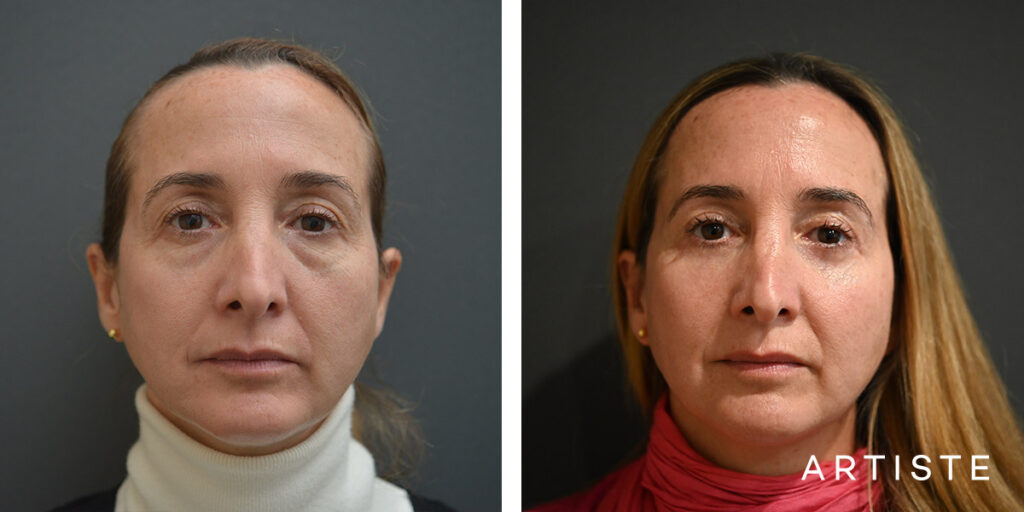How to get rid of bags (fat herniation) under your eyes?
Model featured in photography

Bags under the eyes may present as mild swelling, puffiness, or darkened skin, which some people associate with a tired or stressed appearance. These changes can occur due to a variety of factors, including age, genetics, or lifestyle habits. While there are many ways to address undereye bags, such as lifestyle adjustments, skincare products, or non-invasive treatments, some individuals may explore surgical options like lower blepharoplasty.
It’s important to note that lower blepharoplasty, while technically able to reduce undereye bags by removing or repositioning fat and excess skin, is a highly invasive procedure that comes with inherent risks like infection, unintended changes to the eye’s shape or function, or scarring.
Surgery is not a decision to take lightly and is generally considered only after other less invasive methods have been thoroughly explored and discussed with a qualified healthcare professional.
What are the causes of undereye bags?
Undereye bags are triggered when the skin and muscles supporting your eyelids deteriorate. The skin around the eye area may start to sag. Fat around the eye region can move into the area below your eyes. Likewise, the space below your eyes can gather fluid. It can contribute to the swelling and puffiness of your eyes.
Here are several factors that cause undereye bags:
- Too much sun exposure.
- Frequent alcohol intake.
- Lack of sleep.
- Tobacco use.
- Allergies.
How to get rid of undereye bags?
Undereye bags can make a person’s skin look dull-looking and stressed. To manage its appearance, here are several ways to reverse them.
- Stay hydrated. Water is a simple way to help minimise the appearance of undereye bags. It also aids in the moisture of your skin.
- Avoid the use of tobacco. Smoking has components that contribute to the formation of eye bags. Even frequent exposure to secondhand smoke could also trigger undereye bags.
- Use a cold compress. Undereye bags can be relieved by this simple method. Although it may not fully reverse visible undereye bags, it could decrease the puffiness and swelling.
- Lower Eyelid Blepharoplasty (Invasive and risky procedure. Choose this option only once you’ve thoroughly consulted with your healthcare professional) Lower eyelid blepharoplasty may address under-eye bags, excess skin, and wrinkles in the lower eyelid area. The surgery involves making incisions either on the inside or the lower eyelid or just below the lash line. It may offer aesthetic improvements but it also carries several risks and complications like infection and bleeding, eyelid malposition, dry eyes, vision changes.
Given the risks, you must consult thoroughly with a qualified healthcare professional to determine if this procedure is appropriate.
Reversing the appearance of under-eye bags often involves lifestyle changes, skincare routines, or medical interventions. In some cases, a procedure like lower eyelid blepharoplasty may be an option to address concerns about the appearance of the lower eyelid area. However, it is essential to understand that any surgical procedure comes with risks, including infection, scarring, and potential complications, as well as variability in outcomes.
Do not ever take the decision to pursue plastic surgery lightly. It’s a deeply personal choice and you should feel comfortable throughout the entire process. Open communication with your surgeon is important and if at any point you have nagging doubts about pushing through with the procedure, voice these concerns with your surgeon.
Disclaimer: At Artiste Plastic Surgery, our Plastic Surgeons led by Dr Jack Zoumaras have been trained to the highest possible degree. All surgery has risks and it is always advised to get a second opinion. Risks are very real and we cannot guarantee any result. Results are illustrated as a guide only. All risks are managed and any need for revision surgery or complications (1-5%) can be managed by our specialist plastic surgeons.
Any statements on how you will feel is based on Level V Evidence:
Level V: How you will feel after plastic surgery varies between individuals, depending on psychological and physical factors. Our internal research is based on how patients in our practice feel after surgery.
The blogs are not a substitute for a medical consultation and do not form as part of the doctor to patient relationship.
SHARE THIS ARTICLE
Aug27
What Men Need to Know About Facial Rejuvenation
Disclaimer: At Artiste Plastic Surgery, our Plastic Surgeons led by Dr Jack Zoumaras have been trained to the highest possible degree. All surgery has risks and it is always advised ...
Aug27
Signs You’re Ready for a Facelift
Disclaimer: At Artiste Plastic Surgery, our Plastic Surgeons led by Dr Jack Zoumaras have been trained to the highest possible degree. All surgery has risks and it is always advised ...
ABOUT ARTISTE
Artiste Plastic Surgery is an Award Winning Specialist Plastic Surgery practice led by internationally trained Dr. Jack Zoumaras, Plastic Surgeon and Peer Reviewed Face Surgeon
Artiste offers the latest Cosmetic Surgical Procedures of the Face, Breast and Body, inspired from leading centres around the world.
STAY IN THE LOOP
Enter your email address below to receive updates on new articles and VIP access to promotions and special offers.
FOLLOW US ON INSTAGRAM
